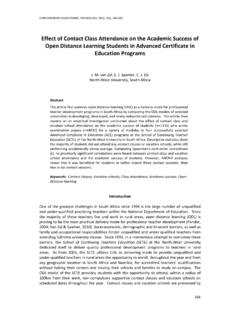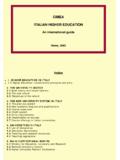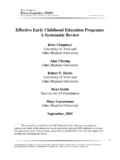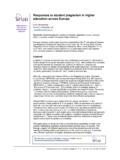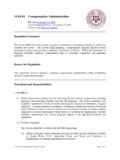Transcription of Key Factors for Determining Students’ Satisfaction …
1 CONTEMPORARY EDUCATIONAL TECHNOLOGY, 2011, 2(2), 118-134. Key Factors for Determining students ' Satisfaction in Distance Learning Courses: A Study of Allama Iqbal open university Afzaal Ali Israr Ahmad International Islamic university , Pakistan Abstract Most of the people in Pakistan perceive distance learning as of poor quality. Therefore, the researchers conducted this study to find out whether it's only people's perception or is there anything in reality, concerning the poor performance of the distance learning students compared to traditional students . Consistent with this rationale, the main purpose of this study was to examine the relationship between student Satisfaction and the following variables of the distance learning environment: Instructors' performance, course evaluation, and student-instructor interaction. The sample consisted of 245 students of Allama Iqbal open university of Pakistan. Keeping in view the nature of relationships among the variables, correlation matrix and regression analysis in addition to frequency analysis were used to analyze the findings.
2 The results showed that just like in traditional education, in distance learning at AIOU, enough interaction takes place between students and instructors; courses are up to date and well-designed; instructors are devoted, motivated, and equipped with the required competencies. Moreover, the faculty at AIOU is delivering distance courses that meet students ' needs with regard to student-instructor interaction, instructor performance, and course evaluation. Key words: Distance learning; Student Satisfaction ; Instructor performance; Student-instructor interaction; Course evaluation Introduction In recent years, the growth of online educational programs has been fueled by the advancement of the internet and modern information technology that changed the face of education (Sher, 2008). The World Wide Web (www) has become a valuable educational means and offers new educational experiences for students , which were not earlier possible.
3 Due to the advancement of the latest technology, online education has emerged as an alternative or at least a considerable supplement to traditional mode of teaching and learning (Waits & Lewis, 2004). Especially in higher education, online education is increasingly becoming common and emerging as an opportunity for delivering entire education online (Johnson, 2004). In academia, through online classes, universities now have the ability to provide distance learning opportunities for students --- full-time or part-time, traditional or non-traditional and international or local, who perhaps have had limited access to advanced educational opportunities (Bartley et al., 2004). 118. CONTEMPORARY EDUCATIONAL TECHNOLOGY, 2011, 2(2), 118-134. The rising demand and growing consumer experience with flexible education programs to support career development and lifelong learning has increased people's expectations for quality instruction, effective educational outcome, and finally Satisfaction for learning (Debourgh, 1999).
4 Allen et al. (2002) and Wang (2003) argued that in any educational institution, the Satisfaction of a student can be determined from his level of pleasure as well as the effectiveness of the education that the student experiences. students with higher levels of Satisfaction towards various aspects of e-learning courses are reported to show considerably higher levels of learning than students with low level of Satisfaction (Fredericksen, 2000). In this regard, specifically instructors of e-learning courses can increase their students ' Satisfaction by considering the primary Factors of student Satisfaction (Ho et al., 2002). No doubt, new telecommunications hardware and software provide many opportunities of communication and collaboration for students and instructors, separated from each other due to time difference and space (Belanger & Jordan, 2000). However, besides a perception of the technological innovation, interaction among students , as well as quality and timely interaction between the student and the teacher, flexibility of online courses, availability of technical support, and consistent instructional design across courses are also important to assure the development of distance education (Lao & Gonzales, 2005; Swan et al.)
5 , 2000; Young & Norgard, 2006). Conrad (2006) argued that distance learning occurs when students and instructor do not meet personally in the same physical space. Similarly, Roffe (2002) described that distance learning refers to the way people communicate and learn by electronic means, which has emerged as a key source of competitive advantage in the information society. The term distance learning is also used interchangeably with terms like e-learning, online learning, online collaborative learning, virtual learning, web-based learning and technology-mediated learning. In the past, few relevant studies have been conducted on the use of distance learning environment in Pakistan. Therefore, this current research study deals with several Factors which have influenced students ' Satisfaction with distance learning in Pakistan. In this perspective, the primary objective of this research study was to examine the relationship between student Satisfaction and the following variables of the distance learning environment: Instructors' performance, course evaluation and student-instructor interaction.
6 Actually, this study was conducted to address the most recent problems of AIOU students , relevant to their distance learning experiences. The fact is that most of the people in Pakistan perceived distance learning as of poor quality. Entrepreneurs, private employers and many corporate executives have almost the same perception. Moreover, they are not ready to accept the argument that distance learning students do just or even better than face to face classroom students . Despite the fact that the AIOU degree is accepted and recognized by the government, getting jobs, particularly good jobs are very difficult for these students . Therefore, the researchers conducted this study to find out whether it's only people's perception or is there any evidence in reality about the poor performance of the distance learning students as compared to traditional students . That's why we posed various questions to AIOU students about their individual Satisfaction regarding instructor performance, student-instructor interaction, and general course evaluation.
7 119. CONTEMPORARY EDUCATIONAL TECHNOLOGY, 2011, 2(2), 118-134. Secondly, this study was carried out by keeping in view the increasing demand for distance education not only in Pakistan but all over the world. Right now there is only one degree awarding university in Pakistan providing distance education (Allama Iqbal open university AIOU). Thus, we focused on AIOU in this study. The AIOU was established in May 1974 in Islamabad, Pakistan and was the first open university in Asia, and the biggest university in the country with course enrolment of 1,806,214 by the year 2004-2005. The AIOU established over 1400 study centers, 9 regional campuses, 23 regional centers, 90 part-time regional coordinating offices throughout Pakistan. Basically, AIOU is a distance education institution, which provides multidisciplinary education from basic to doctoral level programs. In AIOU more than 70 percent of students are employed and the rural-urban distribution of the students is 58% and 42% respectively.
8 Moreover, female enrolments are more than 50 percent. The Internet, audio and video lectures along with correspondence with the instructors are used as a medium of instruction as well as a source of information. In addition, these lectures are broadcasted on television and radio; CDs of these lectures are also available for the students . Literature Review Student Satisfaction The dynamic expansion of online teaching and learning has been boosted significantly by the rapid development of the internet and various web resources, having a tremendous impact on the quality of teaching and learning (Kramer, 2000). Zaidel (2007) added that the use of information technology becomes well-known in education. Modernized way of communication came into being, which change the preference of students from face-to-face to online education. Furthermore, the availability of distance education, the course offerings, and the increasing number of students enrolled, all speak to the importance of this method of instruction (Zapalska &.)
9 Brozik, 2006). Brownson and Harriman, (2000) argued that students in distance learning do just or even better than face to face classroom students . Besides, Johnson et al. (2000) made a comparative research study and did not find any significant difference in the effectiveness of online learning versus face to face course learning for students . Furthermore, distance education provides independent, student-centered and tutor-guided engagement that facilitates interactions with instructors and students which may not always be possible within the traditional classroom setting (Michailidou & Economides, 2003). Astin, (1993). defined student Satisfaction in term of student's perception towards his/her college or university experience, and perceived significance of the education that (s)he received from an institution. Levy (2003) concluded in his research study, which was conducted over 200 students attending e- learning courses, that students ' Satisfaction with e-learning is an important factor to measure the effectiveness of e-learning.
10 120. CONTEMPORARY EDUCATIONAL TECHNOLOGY, 2011, 2(2), 118-134. Instructor Performance and Student Satisfaction In an online learning environment, the instructor is required of a new set of skills for success since latest technologies brings as much change to instructors as they do to students (Jones, 2003). Now, the roles of the instructors change from being the primary source of students ' knowledge to being the manager of the students ' knowledge resources (Romiszowski, 2004). Moreover, in an effective online learning environment, instructor plays a central role. It is not only because of technology but practical accomplishment of the technology that has certain effects on learning (Collis, 1995). An instructor has a definite role to make the online environment successful. For this purpose, instructors must ensure required level of interactions and discussions with their students (Hong et al., 2003). However, interaction is different in this environment (Walker & Hackman, 1991) with more emphasis on the instructor's role as a mediator between the student and the materials (Beaudoin, 1990) or between the student and the technology (Hillman et al.)


